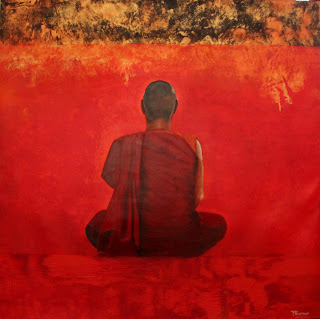The work has been inspired by the well known incident in the epic Ramayana when the female protagonist, Sita, (right hand in 'abhaya' mudra of fearlessness and left indicating charity or compassion. She is also depicted here by the " the plough" and the Lotus) is persuaded by the antagonist Ravana (asking for "bhiksha" as the alms bowl in the work), to cross the line drawn by Lakshmana, depicted by the footprint across the line, thereby leading to the escalation of the epic to it's climax. The work also depicts the kidnapping of Sita. The horse is representative of the infamous "Apaharan". Also visible is the golden deer of temptation, and in the background is the Shesh Naag (interesting in mythological continuity Ram is the Avatar of Vishnu , who is always protected by the Shesh Naag hence representing Lakshman, and who is the Avatar of the Shesh Naag)
To the artist the crossing of the line by Sita is a point of inflection and has substantial social relevance even today.
Acrylic on canvas | 36" X 48"
Status: Available via Gallerie Artistique






.jpg)






.jpg)
.jpg)